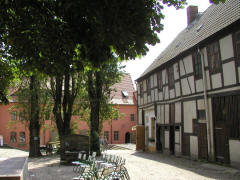|
Page 1 2 3 4 5 6 7 8 9 10 11 12 Wittenburg
Sunday, 6 October. We were up at 7:25. The sky was
completely overcast and the ground was wet, but the rain
had stopped by the time the bus left at 9:30 for our
city tour of Wittenburg. The official name of the city
has been changed to Lutherstadt Wittenburg in
recognition of the vital role it played in the beginning
of the Protestant Reformation. Unlike Dresden and many
other historic German cities, Wittenberg's old city
center was not destroyed during World War II.
Of course, Wittenberg is where Luther triggered the Protestant Reformation in 1517 by writing a letter to his bishop enclosing 95 theses protesting the sale of indulgences. There is some question about whether he actually posted the theses on the door of All Saints' Church (a.k.a. Castle Church) as the story is generally told. In any event, Luther was a monk and priest in the Augustinian monastery here and taught theology at the University of Wittenberg. Upon Luther's final break with the Catholic church in 1521 (and even before), Prince Frederick III, Elector of Saxony, protected him and later gave him the residence halls of the monastery as a home for him and his family.
Our bus tour was entirely within the old walled city.
It started with a brief
stop at east end to see the famous doors
of All Saints' Church. We learned
that the original wooden doors burned in 1760 and were
replaced by the present bronze doors in 1858.
The bus then took us all the way to the opposite end of town, past the Luther oak (also not original) to Lutherhaus, where he lived with his family from 1524 until his death in 1546. The building then deteriorated greatly until it was restored in 1853-1856. It is considered to be the world's premier Reformation museum. One item that shocked me, though, was a plaster death mask of Luther showing a grossly obese face. I've read that he weighed 330 pounds when he died. (There was a German saying, “as fat as Martin Luther.”) But why would they display such a thing? I couldn't help but remember that a nun in my elementary school had mentioned Luther's obesity, implying that it showed he was not a holy man. Leaving Lutherhaus, Jutta led us east down College Street toward the center of the old town. We passed Melanchthon House (1536), now a museum. It was the home of a friend and supporter of Luther said to be the first systematic theologian of the Protestant Reformation. At this point, Jutta the gave us free time to continue on our own. Jane and I continued on to St. Mary's Church (a.k.a. Stadt Kirche or City Church)(dating to 1280) and went inside. This is the church where Luther preached. A short way further along, we came to the Cranach Courtyard (1521) between the home and workshop of a renowned painter. As we left Markt Platz we passed the old City Hall (1535, largely rebuilt 1926-28). We continued down Schloss Street to Castle Church for a better look at the renowned doors where Luther may (or may not have) posted his theses. That's where we were to catch our bus at 12:00 to return to the ship. A light drizzle started just as we got off the bus. A little later it rained fairly hard, then stopped altogether. We were glad it hadn't rained while we were on the walking tour. Otherwise the day had been quite mild with the temperature reaching 60 degrees. We had lunch at
1:00. At 2:30 the bus took us to a nearby village for
our two hour home-hosted visit with a local family. We
were with a group of eight that visited a mother with
three children, ages five to thirteen. Our hostess spoke
almost no English, but one of our group was fluent in
German so that was no problem. The family seemed
reasonably well off, and the children appeared to have
more toys and other possessions than most American
children.
The bus got us back to the ship at 5:00. The port talk was at 6:45 and dinner at 7:00. We were nearing the end of the cruise, and the traditional crew show started at 8:50. It was better than most we'd seen on river ships and ended with a wild Gangnam-Style dance in which the entire crew (including the Captain) and much of the audience participated. The party finally started breaking up about 10:30.
Copyright © 2000-2023 DarrellPeck.com All rights
reserved. | |||

